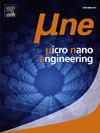In situ measurements of thermal and pressure dependent stress in SOG films by phase shifting interferometry
IF 3.1
Q2 ENGINEERING, ELECTRICAL & ELECTRONIC
引用次数: 0
Abstract
Hydrogen silsesquioxane (HSQ) and Medusa are spin-on-glasses used for several applications and more specifically for electron-beam lithography. To characterize the thermal densification of these resists on silicon, the mean resist film stress was measured in situ as function of temperature up to 600 °C in a vacuum chamber by the curvature method. The curvature was evaluated from 3D profiles of uncoated and coated dies measured by full field phase shifting interferometry. Three resists were investigated: FOx-15, FOx-25 and Medusa-82. The initial resist stress at room temperature after spin coating and baking is slightly tensile and becomes highly tensile above a certain temperature dependent on the resist. This variation is mainly attributed to resists densification. FOx-15 and FOx-25 start densifying at 500 °C, and FOx-25 densifies more than FOx-15. Medusa-82 is densifying around 300 °C and has the highest tensile stress but the film relaxes beyond 405 °C. In the case of FOx-15, it was found that vacuum annealing prevents densification. Finally, we evaluated the in-plane average coefficient of thermal expansion of the resists from stress measurements during cooling to room temperature. For FOx-15, a CTE equal to 1.5 ppm/K is found, while it is close to 0.0±0.2 ppm/K for FOx-25 and 1.3 ppm/K for Medusa-82.

用相移干涉法原位测量SOG薄膜中的热和压力相关应力
氢硅氧烷(HSQ)和美杜莎是用于多种应用的自旋玻璃,更具体地说是电子束光刻。为了表征这些电阻在硅上的热致密性,在真空室中使用曲率法测量了温度高达600°C时电阻膜的平均应力。利用全场移相干涉法对未涂覆模具和涂覆模具的三维轮廓进行了曲率评估。研究了3种抗虫剂:FOx-15、FOx-25和Medusa-82。经旋涂和烘烤后的抗蚀剂在室温下的初始应力是微拉伸的,在一定温度以上根据抗蚀剂的不同而变为高拉伸的。这种变化主要归因于抗蚀剂致密化。FOx-15和FOx-25在500℃时开始致密化,FOx-25的致密化程度高于FOx-15。Medusa-82在300°C左右致密化,拉伸应力最高,但在405°C以上薄膜松弛。在FOx-15的情况下,发现真空退火可以防止致密化。最后,我们评估了从冷却到室温的应力测量中电阻的面内平均热膨胀系数。对于FOx-15,发现CTE等于1.5 ppm/K,而FOx-25和Medusa-82的CTE接近0.0±0.2 ppm/K和1.3 ppm/K。
本文章由计算机程序翻译,如有差异,请以英文原文为准。
求助全文
约1分钟内获得全文
求助全文
来源期刊

Micro and Nano Engineering
Engineering-Electrical and Electronic Engineering
CiteScore
3.30
自引率
0.00%
发文量
67
审稿时长
80 days
 求助内容:
求助内容: 应助结果提醒方式:
应助结果提醒方式:


